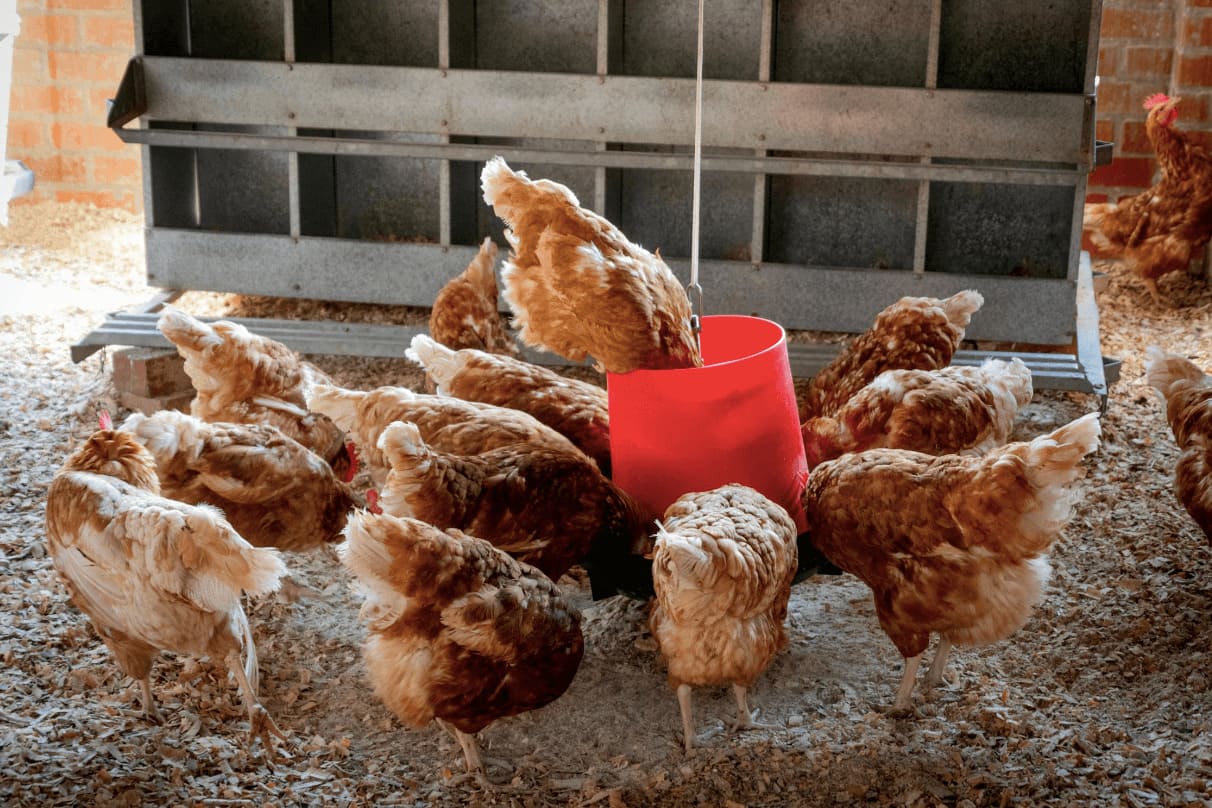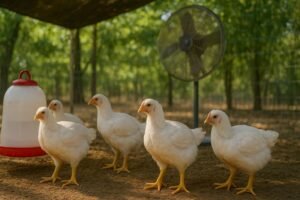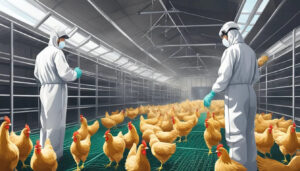Whether you’re raising chickens for meat (broilers) or eggs (layers), one of the biggest questions is how to feed them correctly. This guide is for backyard keepers and small-flock owners who want to make sure their chickens get the right amount of food and water at the right times. We will cover feeding schedules for both broilers and layers, their lighting and water needs, and common mistakes to avoid, making this a complete resource for your flock’s nutritional needs.
Quick Answers
- How many times should broilers be fed in a day? Broilers do best with constant, free-choice access to feed.
- How many times should layers be fed? Layers also need complete feed available at all times for the best egg production.
- Do broilers need light at night? Only for the first 2-3 days. After that, they need a daily dark period to rest.
- Is it good to feed layers at night? No, layers need 8-10 hours of darkness to rest and maintain a healthy laying cycle.
- How much feed do layer hens eat per day? About 0.25–0.33 lb (113–150 grams) per hen, but this varies by breed and climate.
- Can you feed chickens twice a day? Yes, but you must provide enough food in those two meals to meet their full daily needs. Constant access to water is critical.
How many times a day should chickens be fed?
The answer depends on your flock type. Both broilers and layers perform best with constant feed access rather than scheduled meals. Broilers need ad libitum feeding to support their rapid growth rate, consuming feed throughout the day and night (except during dark periods). Layers similarly need consistent nutrition access to maintain daily egg production, as any feed restriction can immediately impact laying rates.
How many times should broilers be fed in a day?
In modern poultry care, broilers are fed ad libitum, which means they have free-choice access to food 24/7. The most effective broiler feeding schedule is not a schedule at all, but rather a constant supply. You should not feed them in scheduled “meals.” The goal is to let them eat whenever they are hungry to support their rapid growth.
Why Free-Choice Feeding is Best for Broilers
Broilers have been bred for extremely rapid growth. Their high metabolism requires a constant supply of energy and protein to develop muscle tissue quickly. Restricting their feed, even for a few hours, can slow this rapid growth. Free-choice feeding ensures they can eat whenever they need to, matching their natural metabolic demands.
Choosing the Right Feed and Feeder
Keep their feeders full of a complete broiler ration. Standard poultry nutrition guidelines, detailed in resources like the Ross Broiler Handbook (Aviagen), recommend changing the feed formula as they grow:
- Starter (Weeks 1-2): High in protein (~23%) to kick-start growth.
- Grower (Weeks 3-5): Slightly lower protein (~20%) to support steady development.
- Finisher (Final 1-2 weeks): Lower protein again (~18%) to prepare for processing.
Many of these feeds contain a coccidiostat, a medicine to prevent a common intestinal disease called coccidiosis. Always read the feed bag label. Breeder handbooks also recommend providing at least 2-3 inches of feeder space per bird to prevent competition.
How many times should layers be fed?
Just like broilers, laying hens (layers) should have a complete layer feed available at all times. As emphasized in extension guides like Keep layers productive: continuous feed (OSU Extension), the best layer feeding schedule is one of constant availability to maximize egg output and maintain flock health. Restricting their food can cause stress and will quickly lower their egg production.
The Link Between Constant Feed and Egg Production
It takes a hen’s body about 24 to 26 hours to produce one egg. This process demands a huge amount of energy, protein, and calcium. If a hen runs out of feed, her body may see it as a sign of scarcity and immediately stop the egg-production process to conserve resources. This is why keeping a feeder full is essential for a consistent supply of eggs, a point confirmed in practical guides like Raising baby chicks (OSU Extension).
Do broilers need light at night?
For the first 48 to 72 hours of life, broiler chicks need nearly continuous light (23-24 hours). This helps them easily find their food and water in the new environment of the brooder.
After those first few days, a proper broiler lighting program with a daily dark period is very important. Most breeder programs and university guides, such as the Ross Broiler Handbook (Aviagen) and Lighting for small-scale flocks (UMaine Extension), recommend a daily dark period of 4 to 8 hours for improved animal welfare.
Benefits of a Broiler Dark Period
A daily broiler dark period is not just about saving electricity; it’s crucial for welfare. This rest period:
- Improves Leg Health: It encourages a natural rest-and-activity cycle, which helps bones develop properly.
- Reduces Stress: Constant light can be stressful and lead to aggressive behaviors.
- Lowers Mortality: It has been shown to reduce rates of metabolic diseases like Sudden Death Syndrome.
Avoid keeping the lights on 24/7 after the first three days. Use a simple timer to manage the schedule consistently.
Broiler Lighting Schedule by Age
| Age | Hours of Light | Hours of Dark | Purpose |
|---|---|---|---|
| Days 0–3 | 23 hours | 1 hour | Help chicks find feed and water. |
| Days 4–7 | 18-20 hours | 4-6 hours | Introduce a rest period for better health. |
| Growing to Finish | 16-20 hours | 4-8 hours | Maintain a stable rest-and-eat cycle. |
Is it good to feed broilers at night?
While broilers have 24/7 feed access, they naturally eat less during their mandatory dark period. This rest is essential – don’t add extra lighting just to encourage night eating. The dark period improves leg health, reduces stress, and lowers mortality from metabolic diseases.
Is it good to feed layers at night?
Many keepers ask, do layers need feed at night? The answer is generally no. Laying hens need a consistent daily cycle of light and dark, called a photoperiod. For the best egg production, hens need about 14-16 hours of light and a solid 8-10 hours of darkness for rest, as detailed in the University of Maine’s bulletin on Lighting for small-scale flocks (UMaine Extension). Interrupting their dark period with chicken night feeding can disrupt their laying cycle.
How Light Stimulates Egg Laying
The layer photoperiod is a critical environmental cue. Daylight signals a hen’s pituitary gland to produce the hormones that trigger ovulation. A long, consistent day length tells her body it’s the prime season for laying eggs. When considering if night lighting chickens good or bad, for layers, a consistent dark period is essential for their health and productivity.
How much feed do layer hens eat per day?
A typical laying hen will eat about 0.25 to 0.33 pounds (around 113 to 150 grams) of feed each day. This is the average chicken feed intake per day for most common breeds, so a typical layers daily ration grams will fall in this range.
Factors That Influence Feed Intake
This amount is highly dependent on breed and climate. You must adjust your expectations based on several factors:
- Breed: Smaller, lighter breeds like Leghorns will eat less than larger, dual-purpose breeds like Orpingtons.
- Climate/Temperature: Hens eat more in cold weather to generate body heat and significantly less in hot weather.
- Age and Production: A young hen in her peak laying period will eat more than an older hen whose production has slowed.
- Foraging: If your hens are free-range, they will supplement their diet with insects and plants, reducing their intake of commercial feed.
Ensure their feed is a complete layer ration with about 16% protein and 3-4% calcium, as defined by the Nutritional requirements of poultry (Merck Vet Manual). The calcium is crucial for strong eggshells. Many keepers also provide a separate bowl of oyster shell calcium so hens can take extra if they need it.
Can you feed chickens twice a day?
So, how many times a day should chickens be fed if you can’t provide feed 24/7? Yes, you can feed chickens twice a day, but this is generally not recommended because it can accidentally lead to underfeeding. If you choose this method, you must offer enough feed for the birds to eat their fill within about 30-60 minutes. A good schedule would be once in the early morning and once in the late afternoon. However, their water must always be available.
How long can broilers stay without water?
Broilers should never be without water. Birds drink about twice as much water as they eat feed by weight, a key metric highlighted by Mississippi State University’s guide on Water quality and quantity influence flock performance. For example, if broilers consume 100 pounds of feed, they’ll drink about 200 pounds (24 gallons) of water. Going even a few hours without water can hurt their growth and health, especially in hot climates. Properly watering chickens heat stress is critical, as they drink significantly more in warm weather.
The Role of Water in a Chicken’s Body
Water is critical for:
- Digestion: Softening feed and helping with nutrient absorption.
- Temperature Regulation: Chickens don’t sweat; they pant to cool down, which uses a lot of water.
- Nutrient Transport: Moving nutrients throughout the body.
A sudden drop in how much water your flock is drinking is often the first sign of a problem. Always provide unlimited access to clean, fresh water, and check waterers at least twice a day.
What color light is best for broiler chickens?
Most successful farms use simple dimmable white LED lights. While some research on blue vs red light for broilers suggests blue can have a calming effect and green may promote early growth, the results are mixed. The most important things are maintaining a consistent light schedule and ensuring the light is the proper intensity (lux). For small flocks, a standard dimmable white LED is perfectly effective. Focus on a good management program rather than a specific color of light.
How to know if chickens are cold at night?
You can tell if chickens are cold at night by watching their behavior. These are common chicken cold stress signs:
- Huddling: All the chickens are bunched together tightly.
- Puffed Feathers: They puff out their feathers to trap air and keep warm.
- Lethargy: They seem tired and don’t move around much.
- Tucking a Foot: A chicken might stand on one leg, tucking the other up into its breast feathers for warmth.
To keep them warm, make sure their coop is free from drafts at their roosting level but still has good ventilation high up to let moisture escape, a common issue discussed in our coop ventilation mistakes guide. Deep, dry litter on the floor also provides excellent insulation. Managing your coop for the weather is crucial, and this is especially true during challenging seasons like Harmattan.
Is too much water good for broilers?
Unlimited access to clean water is essential and good for broilers. A chicken will not dangerously drink “too much” water on its own. However, problems can arise from poor water quality, as detailed in publications like Water quality for broilers (MSU Extension). High levels of Total Dissolved Solids (TDS) and improper pH are common issues.
Besides TDS, water pH should ideally be between 6.5-8.5 for poultry. Water with pH below 5 can cause metal corrosion in equipment, while pH above 8.5 makes water sanitizers work poorly and gives water a bitter taste.
If you are using well water, it’s a good idea to have it tested. The National Research Council (1974) provides clear guidelines on water safety for poultry based on TDS levels, measured in parts per million (ppm).
Water Quality Standards for Poultry – TDS Levels:
- Less than 1,000 ppm: Considered safe and should cause no problems for any class of poultry.
- 1,000-2,999 ppm: Generally satisfactory. It might cause slightly watery droppings at the higher end of this range but should not affect the flock’s health or performance.
- 3,000-4,999 ppm: Considered poor for poultry. It often causes watery droppings, can lead to increased mortality, and may decrease growth, especially in turkeys.
- 5,000-6,999 ppm: Not acceptable for poultry. Water in this range will almost always cause health issues, reduced growth, and increased mortality.
- 7,000-10,000 ppm: Unfit for poultry.
- More than 10,000 ppm: Completely unsafe and should not be used for any livestock or poultry.
Water with high TDS levels can make chickens drink excessively to flush their systems, leading to very wet litter, ammonia buildup, and painful foot problems. The key is to always provide clean, high-quality water.
What are signs of an overfed chicken?
Since broilers and layers are usually fed free-choice, chicken overfeeding symptoms are more about feeding the wrong things. The main concern is giving too many treats like scratch grains, kitchen scraps, or bread. This dilutes the nutrition of their complete feed.
The 90/10 Rule for Treats
A good rule of thumb is that treats should make up no more than 10% of your flock’s diet. The other 90% should come from their balanced complete feed.
Signs of a poor diet or too many treats include:
- In Layers: Obesity (being overweight), a drop in egg-laying, and poor-quality eggshells.
- In Broilers: While they are meant to eat a lot, a poor diet can affect their leg health and overall uniformity.
What is the best time to feed poultry?
For broilers and layers on a free-choice feeding plan, time doesn’t matter since food is always available. The chicken feeding times are self-regulated by the birds themselves. If you must meal-feed, the best times are early in the morning and late in the afternoon to match their natural foraging behavior. During hot weather, chickens eat most in the cooler parts of the day, so ensuring feed is available in the morning is especially important.
What are common chicken feed mistakes?
Avoiding these common mistakes will help keep your flock healthy and productive.
Mistake #1: Too Many Treats
Giving too many treats or scratch grains unbalances their diet and can lead to health problems. Stick to the 90/10 rule.
Mistake #2: Inadequate Feeder Space
Not having enough space at the feeder causes competition, and smaller birds may not get enough to eat. Provide at least 2-3 inches of space per bird.
Mistake #3: Wrong Feeder Height
The lip of the feeder should be level with the birds’ backs. If it’s too low, they will waste feed by scratching it out and contaminate it with manure. You can check your setup against this poultry equipment price list to ensure you have the right gear for your flock’s size and age.
Mistake #4: Improper Feed Storage
Store feed in a cool, dry place in a sealed, rodent-proof container. Feed can go stale or moldy, and it can attract pests.
Mistake #5: Using the Wrong Feed for the Age
Do not give high-calcium layer feed to young chicks, as it can damage their kidneys. Likewise, broiler feeds are not formulated for long-term egg production. The specific nutritional needs of poultry at different life stages are well-defined by sources like the Merck Veterinary Manual. To better understand the nutritional differences, learn more about the difference between feed and scratch. Always use the correct feed for the type and age of your birds.
Frequently Asked Questions (FAQ)
Q: Can I mix broiler and layer feed?
A: It is not recommended. Broiler feed has very high protein levels that are not suitable for layers long-term, while layer feed has high calcium levels that can be harmful to a broiler’s kidneys. Always use the appropriate feed for your flock.
Q: Why did my hens suddenly stop laying eggs?
A: A sudden stop in laying can be caused by many factors, including stress, a lack of feed or water, extreme heat or cold, sickness, or the end of a laying cycle (molting). Check their environment and diet first, and consult a vet if you suspect illness.
Q: What is the best way to store chicken feed?
A: Store feed in a sealed, metal container in a cool, dry place. This protects it from moisture, which can cause mold, and prevents rodents and other pests from getting into it.
Q: Is it okay to feed chickens scratch grains as their main food?
A: No. Scratch grains are like candy for chickens—a low-protein, high-carbohydrate treat. They should only be given in small amounts and never replace a complete, balanced feed.
Conclusion
Successfully raising broilers and layers comes down to understanding and meeting their fundamental needs. The key takeaways are simple but crucial: provide constant, free-choice access to the correct type of feed, ensure a consistent lighting schedule with an adequate dark period for rest, and never let them run out of clean, fresh water. By avoiding common mistakes like over-treating and providing the right equipment, you can ensure your flock is healthy, productive, and thriving. Happy flock raising!
Further Reading on ChickenStarter.com
- The Complete Poultry Farming Business Plan for Nigeria
- How to Formulate Your Own Layer Mash
- A Guide to Poultry Biosecurity
Disclaimer: This guide provides general poultry-husbandry information. Always follow local regulations and the specific guides from your chick breeder. For any flock health issues, please consult a veterinarian or your local agricultural extension agent.

Oladepo Babatunde is the founder of ChickenStarter.com. He is a backyard chicken keeper and educator who specializes in helping beginners raise healthy flocks, particularly in warm climates. His expertise comes from years of hands-on experience building coops, treating common chicken ailments, and solving flock management issues. His own happy hens are a testament to his methods, laying 25-30 eggs weekly.



